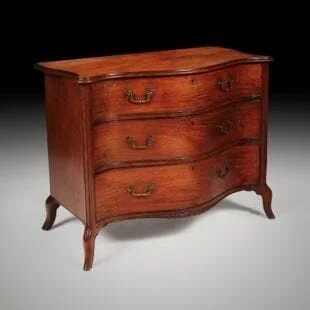A George III serpentine chest of drawers attributed to Henry Hill of Marlborough POA
A George III serpentine chest of drawers attributed to Henry Hill of Marlborough POA
A fine George III mahogany serpentine commode in superb and original country house condition, and attributed to the workshop of Henry Hill of Marlborough. The three graduated drawers retain their original gilt brass handles over a unique carved apron and are flanked by moulded angles continuing into the shaped cabriole feet. A museum quality piece.
England, circa 1770.
Size: 34.3 inches (87cm) high; 41.3 inches (105cm) wide; 22.5 inches (57 cm) deep
Stock Number: VT20305
🔶 On Consignment
Provenance The chest belonged to the late Major General Mark Bond, the last member of the Bond family to live at Moigne Combe, near Dorchester, Dorset. Major General Bond had an illustrious military career: he enlisted as a rifleman in 1940 following the Blitz of London and went on to serve at the Battle of El-Alamein and during the capture of Tunis. In 1943 Mark Bond was taken as a POW but managed to pull off a daring escape from his transport train. He was only recaptured after trying to steal supplies from the Germans. In 1950 Major-General Bond served as aide de camp to Field Marshal Montgomery, then NATO Deputy Supreme Allied Commander in Europe. A letter from Field Marshal Montgomery thanking Mark Bond for his service is held at Moigne Combe. Apart from his distinguished military career,Major General Bond held various prestigious offices in Dorset whilst maintaining an active and thoughtful approach to conservation - he planted over 60,000 trees on the estate.
Attribution Henry Hill was active in Marlborough, Wiltshire,from circa 1740 until his death in 1778. He ran a diverse business encompassing furniture making, coach making, house agency and auctioneering and was described in his obituary as ‘one of the most eminent cabinet-makers and upholsterers in the Kingdom’ an astounding tribute to a cabinet maker working outside London at that period. His clients were predominately Wiltshire landowners including the 9th Duke of Somerset at Maiden Bradley, Paul Methuen at Corsham Court, Henry Hoare at Stourhead, and Earl Bathurst at Cirencester Park. Hill was clearly aware of prevailing London fashions and must have had access to contemporary design publications. He was also known to have employed immigrant labour, most likely German. All this is reflected in the designs of his furniture. His French commodes were made with a number of variations dependent on clients’ needs and budgets but invariably with three drawers and of serpentine form with flame figured veneers or marquetry, ormolu-mounted corners and a lobed front apron, see Thomas Chippendale’s designs for French Commode Tables, Plate LXVI 3rd Edition 1763 The Gentleman and Cabinet-Maker’s Director (first published 1754).















